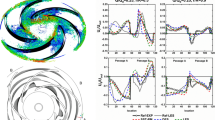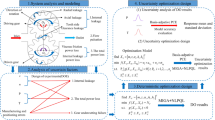Abstract
This paper presents a numerical study on the aerodynamics loss reduction characteristics after the leading-edge (LE) optimization in a low-pressure turbine linear cascade. The LE was optimized with a simple and practical method of “Class Function/Shape Function Transformation Technique” (CST). The simulation conditions, covering the whole working range, were independently determined by incidence, Reynolds number and Mach number. Quantitative loss analyses were carried out with a loss breakdown method based on volumetric integration of entropy production rates. To understand the reason of loss reduction, the local sources at different operating points were identified with entropy production rates. The results showed that LE optimization with the CST method played a positive role in decreasing the total losses, and the working range with lower loss was extended. The profile loss and the endwall loss were significantly reduced by the LE optimization, which were also verified to be the major causes of the total loss reduction by loss breakdown. The decrease of profile loss can be attributed to the boundary layer near the LE region and the boundary layer of downstream at off-design incidence. The reduction mostly came from the pressure side at negative incidence, while came from the suction side at the positive incidence. The endwall loss was decreased markedly about 2.5%–5% by the LE optimization at the incidence of‒12°, which was 1% at the incidence of 12°. The mechanism for the endwall loss reduction at different incidences was different from each other. At negative incidence, the LE optimization diminished the corner separation vortex on the pressure side. While at positive incidence, the benefits came from three aspects, i.e., reduced suction LE separation bubbles close to the endwall, reduced passage vortex strength, and weakened shear process between passage vortex and trailing shed vortex. The loss of the downstream zone was relatively lower than that of the profile losses and the endwall losses. The effect of LE optimization on the loss of the downstream zone at different conditions was complex and it depended both on the profile boundary layer behavior at the suction trailing edge and on the passage vortex strength.
Similar content being viewed by others
References
Goodhand, M.N., Miller, R.J., The impact of real geometries on three-dimensional separations in compressors. ASME Journal of Turbomachinery, 2012, 134(2): 021007.
Goodhand, M.N., Miller, R.J., Compressor leading edge spikes: A new performance criterion. ASME Journal of Turbomachinery, 2010, 133(2): 021006.
Hodson, H.P., Boundary-layer transition and separation near the leading edge of a high-speed turbine blade. ASME Journal of Engineering for Gas Turbines and Power, 1985, 107(1): 127–134.
Ward, J.W., The behavior and effects of laminar separation bubbles on aerofoils in incompressible flow. Journal of the Royal Aeronautical Society, 1963, 67(636): 783–790.
Crimi, P., Reeves, B.L., Analysis of leading-edge separation bubbles on airfoils. AIAA Journal, 1976, 14(11): 1548–1555.
Tani, I., Low-speed flows involving bubble separations. Progress in Aeronautical Science, 1964, 5: 70–103.
Gaster, M., The structure and behavior of laminar separation bubbles. Aeronautical Research Council, 1967, Reports and memoranda, No. 3595.
Davis, M.R., Design of flat plate leading edges to avoid flow separation. AIAA Journal, 1980, 18(5): 598–600.
Carter, A.D.S., Blade profiles for axial flow fans, pumps, compressors, etc. Bristol: Proceedings of the Institution of Mechanical Engineers, 1961, 175(1): 775–806.
Walraevens, R.E., Cumpsty, N.A., Leading edge separation bubbles on turbomachine blades. ASME Journal of Turbomachinery, 1995, 117(1): 115–125.
Lu, H.Z., Xu, L.P., Fang, R., Improvement of compressor blade leading edge design. Journal of Aerospace Power, 2000, 15(2): 129–132.
Wheeler, A.P.S, Sofia, A., Miller, R.J., The effect of leading-edge geometry on wake interactions in compressors. ASME Journal of Turbomachinery, 2009, 131(4): 041013-1-041013-8.
Liu, B.J., Yuan, C.X., Yu, X.J., Effects of leading-edge geometry on aerodynamic performance in controlled diffusion airfoil. Journal of Propulsion Technology, 2013, 34(7): 890–897.
Song, Y., Gu, C.W., Effects of curvature continuity of compressor blade profiles on their performances. Proceedings of ASME Turbo Expo 2014, Düsseldorf, Germany, 2014: ASME GT2014-25804.
Yu, X.J., Zhu, H.W., Liu, B.J., Effects of leading-edge geometry on boundary layer parameters in subsonic airfoil. Journal of Engineering Thermophysics, 2017, 38(10): 2108–2118.
Li, L., Liu, H.X., The analysis of leading edge deformations on turbomachine blades. Energies, 2019, 12(4): 736.
Benner, M.W., Sjolander, S.A., Moustapha, S.H., Influence of leading-edge geometry on profile losses in turbines at off-design incidence: experimental results and an improved correlation. ASME Journal of Turbomachinery, 1997, 119(2): 193–200.
Benner, M.W., Sjolander, S.A., Moustapha, S.H., The influence of leading-edge geometry on secondary losses in a turbine cascade at the design incidence. ASME Journal of Turbomachinery, 2004, 126(2): 277–287.
Mamaev, B.I., Characteristics of turbine cascade with the modified leading edge of a profile. Russian Aeronautics, 2011, 54(4): 372–378.
Bai, T., Zou, Z.P., Zhang, W.H., et al., Mechanism of effect of leading-edge geometry on the turbine blade cascade loss. Journal of Aerospace Power, 2014, 29(6): 1482–1489.
Zhang, W., Zou, Z., Ye, J., Leading-edge redesign of a turbomachinery blade and its effect on aerodynamic performance. Applied Energy, 2012, 93: 655–667.
Cui, T., Wang, S.T., Wang, S., et al., Application of CST method on modifying leading edge of axial-flow turbine blade. Journal of Propulsion Technology, 2019, 40(8): 1771–1783.
Pritchard, L.J., An eleven parameter axial turbine airfoil geometry model. ASME 1985 International Gas Turbine Conference and Exhibit, Houston, Texas, USA, 1985, 85-GT-219.
Hamakhan, I.A., Korakianitis, T., Aerodynamic performance effects of leading-edge geometry in gasturbine blades. Applied Energy, 2010, 87(5): 1591–1601.
Chen, L., Chen, J., Zhao, S.L., et al., Effect of blade leading edge on aerodynamic performance of turbine. Journal of Aerospace Power, 2013, 28(4): 921–929.
Denton, J. D., Loss mechanisms in turbomachines. ASME Journal of Turbomachinery, 1993, 115(4): 621–656.
Hodson, H.P., Dominy, R.G., The off-design performance of a low-pressure turbine cascade. ASME Journal of Turbomachinery, 1987, 109(2): 201–209.
Hodson, H.P., Dominy, R.G., Three-dimensional flow in a low-pressure turbine cascade at its design condition. ASME Journal of Turbomachinery, 1987, 109(2): 177–185.
Kulfan, B.M., A universal parametric geometry representation method - “CST”. 45th AIAA aerospace sciences meeting and exhibit, Reno, Nevada, 2007, AIAA Paper 2007-62.
Gostelow, J.P., Watson, P.J., A closed circuit variable density air supply for turbomachinery research. ASME 1976 International Gas Turbine and Fluids Engineering Conference, New Orleans, Louisiana, USA, 1976, 76-GT-62.
AEA technology. ANSYS CFX user documentation, 2015.
Celik, I.B., Ghia, U., Roache, P.J., et al., Procedure for estimation and reporting of uncertainty due to discretization in CFD applications. ASME Journal of Fluids Engineer, 2008, 130(7): 078001.
Pullan, G., Denton, J., Curtis, E., Improving the performance of a turbine with low aspect ratio stators by aft-loading. ASME Journal of Turbomachinery, 2006, 128(3): 492–499.
Kock, F., Herwig, H., Entropy production calculation for turbulent shear flows and their implementation in CFD codes. International Journal of Heat and Fluid Flow, 2005, 26(4): 672–680.
Zhu, C.M., Xin, D.D., Zhuang, F.G., A new method for visualizing 3-D vortices structures using sectional data. Acta Aeronautica ET Astronautica Sinica, 2003, 2003(3): 193–198.
Acknowledgments
This research is sponsored by the Project NO.51576037 supported by National Natural Science Foundation of China (NSFC).
Author information
Authors and Affiliations
Corresponding authors
Rights and permissions
About this article
Cite this article
Cui, T., Wang, S., Tang, X. et al. Effect of Leading-Edge Optimization on the Loss Characteristics in a Low-Pressure Turbine Linear Cascade. J. Therm. Sci. 28, 886–904 (2019). https://doi.org/10.1007/s11630-019-1196-3
Received:
Published:
Issue Date:
DOI: https://doi.org/10.1007/s11630-019-1196-3




